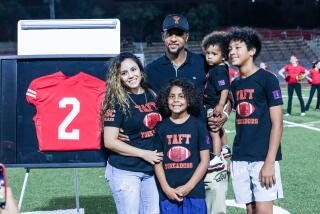The game that taught them life
- Share via
In the documentary “Something to Cheer About,” former players at Indianapolis’ all-black Crispus Attucks high school recall having to step aside when white folks walked toward them on a busy sidewalk. But on the court, especially under the leadership of coach Ray Crowe, they made room for no one.
In 1955, Attucks became the first all-black team to win a state championship, a feat repeated for the next two years. Indiana Pacer Isaiah Thomas praises the “inventive and free-thinking” coaches of the era, while Sen. Richard Lugar calls Crowe’s style, relying on frequent passing and fluid play, “a breakthrough in Indiana basketball.”
The former Attucks players who line up for Betsy Blankenbaker’s camera have a simpler explanation: Crowe taught them to win. Previous coaches were mainly concerned that the players comported themselves like gentlemen, no mean feat in a segregated era when the team had to travel long distances to find enough schools that would play them to make up a full season.
Crowe, who narrator Willie Merriweather says wanted the game to make the boys rather than the other way around, coached his players in life as well as basketball. Merriweather, later All-American at Purdue, says he would have dropped out of high school if not for Crowe’s paternal influence. But he also expected them to win games, which they did with astonishing and often unbroken regularity.
The most famous Attucks alumnus was Oscar Robertson, who went on to become a 12-time NBA All-Star during seasons with the Cincinnati Royals and Milwaukee Bucks. Thomas calls him “a great thinker of the game,” but his fellow players recall him first as a scrawny kid who was allowed to join their pickup games only because he owned his own basketball. Robertson later grew to 6 feet 5, but the nickname “Big O” started out as a joke.
The players’ memories amply document the inequities of segregation, recalling a time when they could sell 10,000 tickets to a game at Butler University’s field house (having long since outgrown their own facilities) but were still not allowed to eat in the school’s cafeteria. Attucks player Bill Hampton describes the prevalence of corrupt officiating, which effectively added the invariably white referees to the other team’s roster. “You looked at it like you’re playing [against] seven guys, and they’re playing [against] five,” he says.
But the movie could have had much greater resonance were it not focused so monolithically on basketball. One wonders what life was like at Attucks High, or how the players’ success on the court affected their lives off it. Blankenbaker treats her subjects with respect, but always from a distance. The movie never gets under their skin or develops an emotional narrative to go with its historical recitation. It’s full of abrupt leaps and blunt conclusions, redundancies and omissions (among them the fact that Attucks, after winning another title in 1959, never returned to the Final Four). “Something to Cheer About” is the outline of a great story, but it never fills in the gaps.
“Something to Cheer About.” MPAA rating: unrated. Running time: 1 hour, 15 minutes. Exclusively at Laemmle’s Grande, 345 S. Figueroa St., downtown L.A , (213) 617-0268.
More to Read
Go beyond the scoreboard
Get the latest on L.A.'s teams in the daily Sports Report newsletter.
You may occasionally receive promotional content from the Los Angeles Times.










